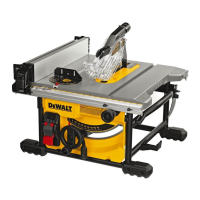14
ENGLISH
OPERATION
Instructions for Use
WARNING: Always observe the safety instructions and
applicableregulations.
WARNING: To reduce the risk of serious personal
injury, turn tool off and disconnect tool from power
source before making any adjustments or removing/
installing attachments or accessories. An accidental
start-up can cause injury.
Bevel Stop And Pointer Adjustment (Fig. K)
1. Raise the blade fully by rotating the blade height
adjustment wheel
6
clockwise until itstops.
2. Unlock the bevel lock lever
7
by pushing it up and to the
right. Loosen the bevel stop screw
38
.
3. Place a square flat against the table top and against the
blade between teeth. Ensure the bevel lock lever is in its
unlocked, or up,position.
4. Using the bevel lock lever, adjust the bevel angle until it is
flat against thesquare.
5. Tighten the bevel lock lever by pushing itdown.
6. Turn the bevel stop screw
38
to rotate the cam until
it firmly contacts the bearing block. Tighten the bevel
stopscrew.
7. Check the bevel angle scale. If the pointer does not read 0°,
loosen pointer screw
39
and move the pointer so it reads
correctly. Retighten the pointerscrew.
8. Repeat at 45°, but do not adjustpointer.
Mitre Gauge Adjustment (Fig. A)
To adjust mitre gauge
10
loosen knob, set to desired angle and
tightenknob.
Body and Hand Position
Proper positioning of your body and hands when operating the
table saw will make cutting easier, more accurate andsafer.
WARNING:
• Never place your hands near the cuttingarea.
• Place your hands no closer than 150mm from
theblade.
• Do not cross yourhands.
• Keep both feet firmly on the floor and maintain
properbalance.
Prior to Operation
WARNING:
• Install the appropriate saw blade. Do not use
excessively worn blades.The maximum rotation speed
of the tool must not exceed that of the sawblade.
• Do not attempt to cut excessively smallpieces.
• Allow the blade to cut freely. Do notforce.
• Allow the motor to reach full speed beforecutting.
To reduce effects of increased vibration, make sure the
environment is not too cold, the machine and accessory are well
maintained and the workpiece size is suitable for thismachine.
WARNING:
• Always observe the safety instructions and
applicableregulations.
• Ensure the machine is placed to satisfy ergonomic
conditions in terms of table height and stability. The
machine site shall be chosen so that the operator
has a good overview and enough free surrounding
space around the machine that allow handling of the
workpiece without anyrestrictions.
• Install the appropriate saw blade. Do not use
excessively worn blades. The maximum rotation speed
of the tool must not exceed that of the sawblade.
• Do not attempt to cut excessively smallpieces.
• Allow the blade to cut freely. Do notforce.
• Allow the motor to reach full speed beforecutting.
• Make sure all locking knobs and clamp handles
aretight.
• Never place either hand in the blade area when the
saw is connected to the electrical powersource.
• Never use your saw for freehandcuts!
• Do not saw warped, bowed or cupped workpieces.
There must be at least one straight, smooth side to go
against the rip fence or mitrefence.
• Always support long workpieces to preventkickback.
• Do not remove any cut-offs from the blade area while
the blade isrunning.
Switching On and Off (Fig. A, L)
The on/off assembly
8
of your saw bench offers
multipleadvantages:
• No-volt release function: should the power be shut off for
any reason, the switch has to be deliberatelyreactivated.
• To switch the machine on, press the green startbutton
40
.
• To switch the machine off, press the red stopbutton
41
.
Lock Off Feature Instructions
A cover above the switch folds down for insertion of a padlock
to lock the saw off. A padlock with a maximum diameter of
6.35mm and minimum clearance of 76.2 mm isrecommended.
Rip Fence Operation (Fig. A, M)
Rail Lock Lever
The rail lock lever
5
locks the fence in place preventing
movement during cutting. To lock the rail lever, push it down
and toward the rear of the saw. To unlock, pull it up and toward
the front of thesaw.
NOTE: When ripping, always lock the rail locklever.
Work Support Extension /Narrow Ripping Fence
Your table saw is equipped with a work support extension to
support work that extends beyond the sawtable.

